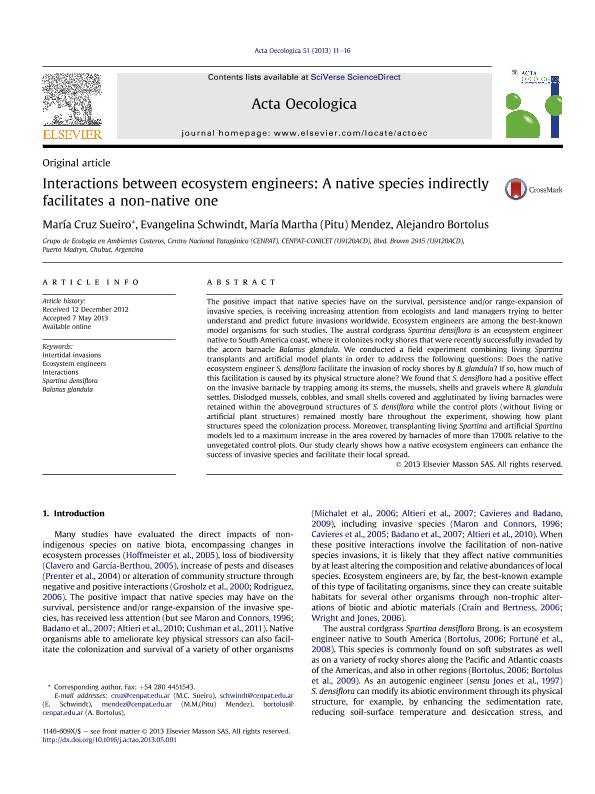Artículo
Interactions between ecosystem engineers: a native species indirectly facilitates a non-native one
Fecha de publicación:
08/2013
Editorial:
Elsevier Masson
Revista:
Acta Oecologica
ISSN:
1146-609X
Idioma:
Inglés
Tipo de recurso:
Artículo publicado
Clasificación temática:
Resumen
The positive impact that native species have on the survival, persistence and/or range-expansion of invasive species, is receiving increasing attention from ecologists and land managers trying to better understand and predict future invasions worldwide. Ecosystem engineers are among the best-known model organisms for such studies. The austral cordgrass Spartina densiflora is an ecosystem engineer native to South America coast, where it colonizes rocky shores that were recently successfully invaded by the acorn barnacle Balanus glandula. We conducted a field experiment combining living Spartina transplants and artificial model plants in order to address the following questions: Does the native ecosystem engineer S. densiflora facilitate the invasion of rocky shores by B. glandula? If so, how much of this facilitation is caused by its physical structure alone? We found that S. densiflora had a positive effect on the invasive barnacle by trapping among its stems, the mussels, shells and gravels where B. glandula settles. Dislodged mussels, cobbles, and small shells covered and agglutinated by living barnacles were retained within the aboveground structures of S. densiflora while the control plots (without living or artificial plant structures) remained mostly bare throughout the experiment, showing how plant structures speed the colonization process. Moreover, transplanting living Spartina and artificial Spartina models led to a maximum increase in the area covered by barnacles of more than 1700% relative to the unvegetated control plots. Our study clearly shows how a native ecosystem engineers can enhance the success of invasive species and facilitate their local spread.
Archivos asociados
Licencia
Identificadores
Colecciones
Articulos(CCT-CENPAT)
Articulos de CTRO.CIENTIFICO TECNOL.CONICET - CENPAT
Articulos de CTRO.CIENTIFICO TECNOL.CONICET - CENPAT
Citación
Sueiro, Maria Cruz; Schwindt, Evangelina; Mendez, María Martha; Bortolus, Alejandro; Interactions between ecosystem engineers: a native species indirectly facilitates a non-native one; Elsevier Masson; Acta Oecologica; 51; 8-2013; 11-16
Compartir
Altmétricas




